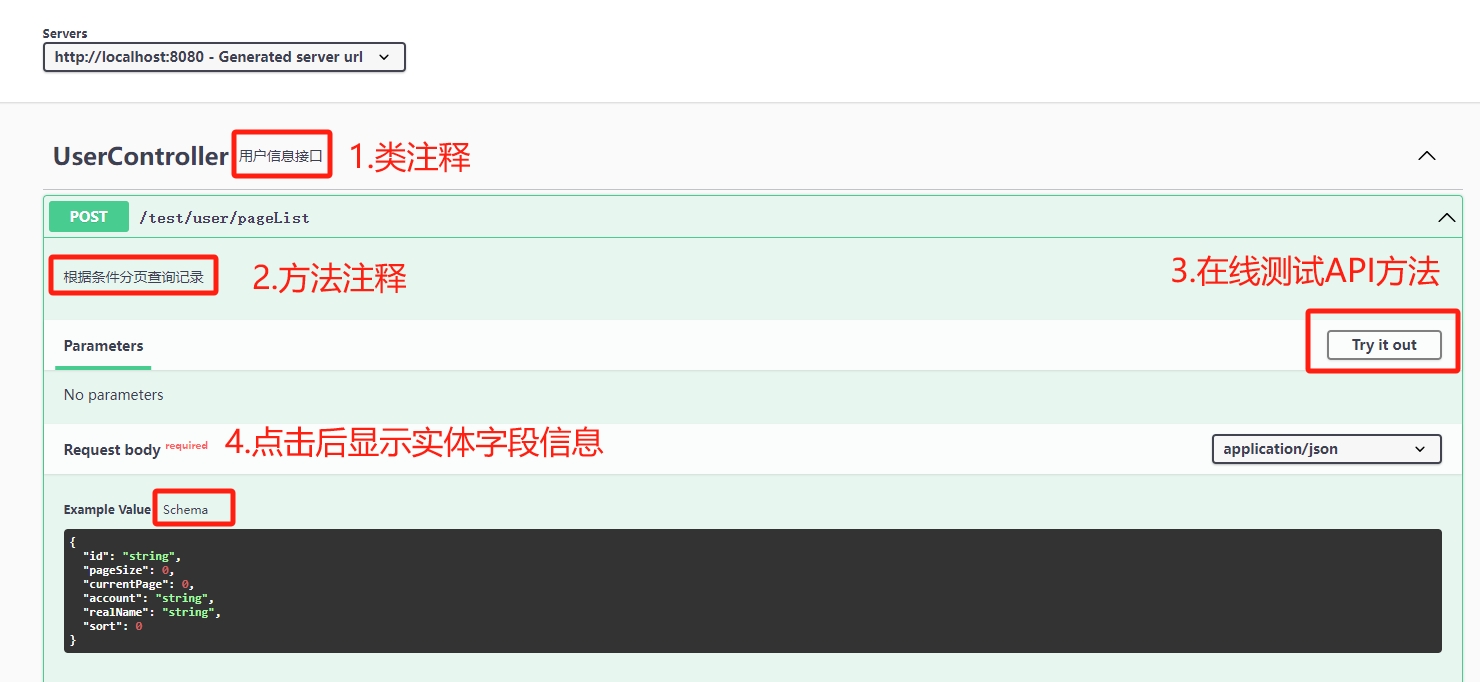如何实现后端开发框架(九)-自动生成API文档
本文介绍如何使用Springdoc(Swagger3)自动生成RESTful API文档。通过在Spring Boot项目中引入springdoc-openapi-ui依赖,并配合@Schema、@Tag等注解标注实体类和接口信息,可自动生成可视化API文档,解决手动维护文档的痛点。文档默认访问地址为/swagger-ui.html,支持实时同步代码变更。
1.问题描述
在前后端分离的软件系统开发中,一般后端完成RESTful API接口后,需要将API使用方法告诉前端来进行集成和联调测试。如果后端采用写API文档的方式,一是很麻烦耗时,而是代码改动后文档也要及时更新才行。有没有更方便的方式来生成API文档呢?
2.实现思路
我们利用Springdoc工具包来根据后端代码自动生成对应的API文档。
Springdoc也叫Swagger3,网上有很多资料说的其实是Swagger2的使用方式。
Swagger2使用的工具包是springfox,Swagger2可以在Springboot 2.3及以下版本中使用。springfox已经很长时间不更新了,不推荐使用。
Swagger3使用的工具包是springdoc-openapi-ui,Swagger3可以在Springboot 2.4及以上版本中使用。
我这里使用的是Springboot 2.6,所以我要使用的是springdoc-openapi-ui工具包。
3.实现步骤
3.1.引入依赖包
这里添加Springboot 2.6对应的Springdoc依赖包版本。
所有Springboot版本号对应的Springdoc版本号见官方文档:https://springdoc.org/#what-is-the-compatibility-matrix-of-springdoc-openapi-with-spring-boot
1
2
3
4
5
<dependency>
<groupId>org.springdoc</groupId>
<artifactId>springdoc-openapi-ui</artifactId>
<version>1.6.7</version>
</dependency>
3.2.配置首页信息
Opendoc完整的配置参数清单见官方文档:https://springdoc.org/#properties
1
2
3
4
5
6
7
/**
* 默认前端页面地址为:http://ip:port/swagger-ui.html <br>
* 默认后端api的json地址为:http://ip:port/v3/api-docs
*/
@Configuration
@OpenAPIDefinition(info = @Info(title = "API", version = "1.0", description = "API v1.0"))
public class OpenApiConfig {}
3.3.使用API文档注解
在实体类中使用:
@TableName:标识数据库表的相关信息
@Schema:标识表字段的相关信息
完整注解使用方法见官方demo:https://springdoc.org/#demos
1
2
3
4
5
6
7
8
9
10
11
12
13
14
15
16
17
18
@Data
@EqualsAndHashCode(callSuper = true)
@TableName("SECURITY_USER")
public class User extends MyBaseEntity {
private static final long serialVersionUID = 1L;
@Schema(description = "登录名")
@TableField(value = "ACCOUNT")
private String account;
@Schema(description = "姓名")
@TableField("REAL_NAME")
private String realName;
@Schema(description = "排序编号")
@TableField("SORT")
private Integer sort;
}
在API方法中使用:
@Tag:标识类的相关信息
@Operation:标识API方法的相关信息
完整注解使用方法见官方demo:https://springdoc.org/#demos
1
2
3
4
5
6
7
8
9
10
11
12
13
14
15
16
17
18
19
20
21
22
23
24
25
26
27
28
29
30
31
32
33
34
35
36
37
38
39
40
41
42
43
44
45
46
47
48
49
50
51
@RestController
@RequestMapping("/test/user")
@Tag(name = "UserController", description = "用户信息接口")
public class UserController extends MyBaseController<UserService, User> {
/**
* 根据条件查询所有记录
*
* @param user
* @return
*/
@Operation(description = "根据条件查询所有记录")
@RequestMapping(value = "/list", method = RequestMethod.POST)
public List<User> list(@RequestBody(required = false) User user) {
List<SqlParam> sqlParams = new ArrayList<>();
SqlParam sqlParam1 = new SqlParam("ACCOUNT", user.getAccount(), SqlOperator.EQ);
SqlParam sqlParam2 = new SqlParam("REAL_NAME", user.getRealName(), SqlOperator.LIKE);
sqlParams.add(sqlParam1);
sqlParams.add(sqlParam2);
SqlParam sortParam = new SqlParam("SORT", SqlOperator.ORDER_BY_ASC);
sqlParams.add(sortParam);
List<User> result = myBaseService.customQuery(sqlParams);
return result;
}
/**
* 根据条件分页查询记录
*
* @param user
* @return
*/
@Operation(description = "根据条件分页查询记录")
@RequestMapping(value = "/pageList", method = RequestMethod.POST)
public MyPage<User> pageList(@RequestBody User user) {
List<SqlParam> sqlParams = new ArrayList<>();
SqlParam sqlParam1 = new SqlParam("ACCOUNT", user.getAccount(), SqlOperator.EQ);
// SqlParam2第三个参数表示“ACCOUNT”和”REAL_NAME“这两个查询条件是”OR”关系,默认是“AND”关系
SqlParam sqlParam2 =
new SqlParam("REAL_NAME", user.getRealName(), SqlOperator.LIKE, SqlOperator.OR);
sqlParams.add(sqlParam1);
sqlParams.add(sqlParam2);
SqlParam sortParam = new SqlParam("SORT", SqlOperator.ORDER_BY_ASC);
sqlParams.add(sortParam);
MyPage<User> result =
myBaseService.customPagingQuery(sqlParams, user.getCurrentPage(), user.getPageSize());
return result;
}
}
4.测试验证
启动后端Springboot系统后:
默认API前端页面访问地址为:http://ip:port/swagger-ui.html
默认后端api的json文件访问地址为:http://ip:port/v3/api-docs
页面功能显示如下:
5.完整代码
完整代码见以下Git仓库中的”api-doc”子项目:
https://github.com/randy0098/framework-samples
